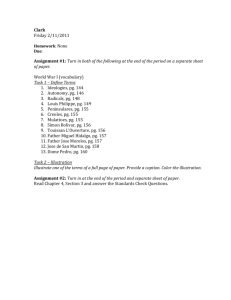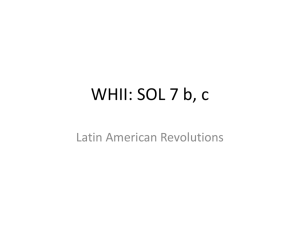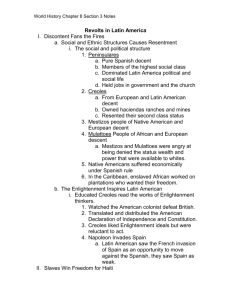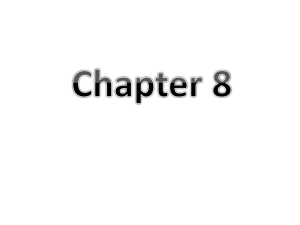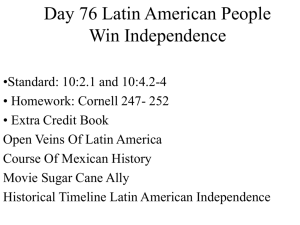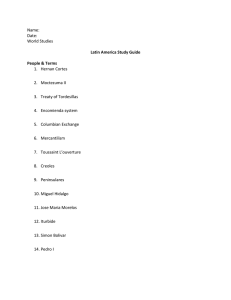world_history_chapter_8
advertisement
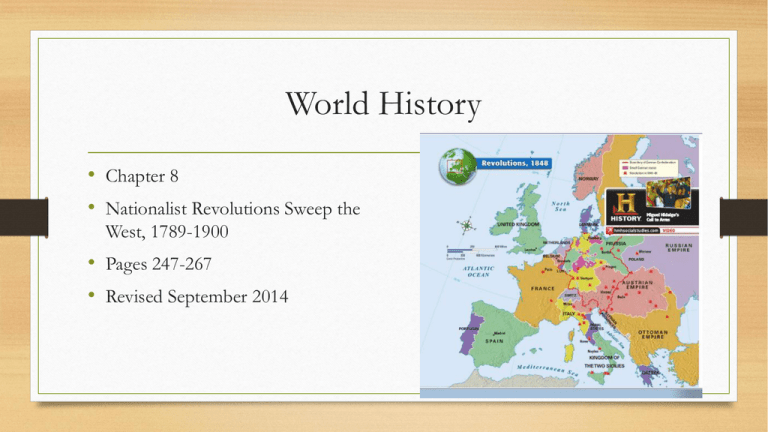
World History • Chapter 8 • Nationalist Revolutions Sweep the West, 1789-1900 • Pages 247-267 • Revised September 2014 Latin American Peoples Win Independence • Section 1 • Pages 247-252 • Spurred by discontent and Enlightenment ideas, peoples in Latin America fought colonial rule. • Sixteen of today’s Latin American nations gained their independence at this time. COLONIES OF SPAIN AND PORTUGAL Spain -controlled most of Latin America Portugal -controlled Brazil 1700s- These colonies grew in wealth and prosperity. European investment. Greater access to information. Education- Learned of Enlightenment and Revolutions 1. How did early struggles in Latin America affect Haiti? • In the early 1800s growing tensions among the different ethnic and social groups of Latin American countries, as well as reforms imposed by colonial authorities, were leading to demands for change. • Haiti was the first territory to break its ties with Europe (France). • Saint Domingue, with its rich sugar exports, had been built with slave labor. • Located on the western half of the Caribbean island of Hispaniola. • Haiti, led by Toussaint L’Overture, (a former slave), declared independence in 1804. • • He was a hero because of his military and political actions. He was imprisoned in France and died in 1803, but the struggle continued. • They re-named the nation Haiti. Saint Domingue Santa Domingo Hispaniola 2. What was the difference between creoles and peninsulares? • In the 1800s, Spain controlled most of Latin America. • This includes present-day Mexico and most of Central and South America. • Portugal governed the large present-day country of Brazil. • Spanish kings had made great improvements in their colonies, thus they enjoyed wealth and prosperity. • This included education, which allowed many to learn about the Enlightenment in Europe. • At this time, tensions mounted between two groups: • • Creoles—people of European descent who were born in the colonies (excluded from top military/gov’t positions) Peninsulares—colonists who were born in Spain (most powerful group) • This also was happening in Portuguese Brazil. • Africans & Indians—largest group, but had very little power (lower classes) • Mulatto—persons of mixed European and African descent Class structure in Latin America • • • • • • Peninsulares Creoles Mestizos Mulattos Enslaved Africans Indians 3. From the view of the colonial powers, why were the creoles the most dangerous part of the population? • Even though they could not hold public office, creoles were the least oppressed of those born in Latin America. • They were the best educated, many traveling to Europe for their education. • Most were trained as soldiers and wealthy. 4. What did Simon Bolivar achieve? Simon Bolivar “The Liberator” led a series of revolutions against Spanish forces in South America. Born to a wealthy creole family in Venezuela and once was an admirer of Napoleon. Twice Bolivar had to go into exile. In 1811, Venezuela declared independence from Spain. Bolivar led a 10 year military campaign. By 1821—Bolivar and his troops had defeated the Spanish in most of northern South America, which includes Venezuela, Columbia, & Ecuador. 5. Who was Jose de San Martin? • Fought against Napoleon in Spain after King Ferdinand VII was replaced by Napoleon’s brother Joseph. • Born in Argentina, he returned home when he learned his country would be fighting for independence in 1816. • Met Bolivar in Ecuador in 1821. • Eventually, San Martin would lead the battle against Spain in all of southern South America. • 1816- Argentina gains independence • Moves to Chile and attacks over the Andes Mountains. • Chile gained independence. • Peru gains independence in 1824. 6. How did Mexico’s fight for independence begin? • • • Napoleon’s conquest of Spain was the spark for Mexican independence. Mexico was inhabited by creoles, peninsulares, Indians, and people of mixed race. In 1810, a small town priest first called for Mexican independence. • • • • He had a history of challenging authority. He made a famous speech on September 16, 1810 calling for independence from Spanish peninsulares. • • Father Miguel Hidalgo was a creole priest. Still today Mexican Independence Day is celebrated on this day. Even though Hidalgo was calling on independence from the peninsulares, Spanish authorities realized the danger of the growing revolution. • After marching towards Mexico City with Indian and mestizo followers, the Spanish army defeated the unruly army of some 80,000. • He was captured and executed, but his movement continued. He is still known as the Father of Mexican Independence. 7. Describe the similarities between Hidalgo and Morelos. • After the death of Father Hidalgo, Father Jose Maria Morelos became the leader of the revolutionary movement. • The rebels rallied around him. • He organized a Mexican congress made up of all ethnic groups. • Creole, Indian, mixed. • He wanted independence with guaranteed freedoms. • Morelos was a strong military leader and took control of parts of Mexico for four years. • He too was captured and executed by Spanish authorities. 8. Who was Augustin de Iturbide and why did he change sides in the Mexican war for independence? • Iturbide was a creole who was loyal to the Spanish king. • These “royalists”, led by Iturbide, were asked to fight a final battle against the revolutionaries in 1820. • However, that same year a liberal revolution was underway in Spain. • Iturbide believed this revolution would take away some of his power. • He decided to switch sides and fight for the Mexican revolutionaries. 9. What did Iturbide propose to Spain? • First, Mexico would gain its independence, but would be ruled by a monarch. • Second, creoles and peninsulares would have equal rights. • Third, the Roman Catholic Church would be the official church of Mexico. • After 10 years of fighting, this compromise brought together many different groups. • Creole, peninsulares, royalists, and rebels all fought together for independence in 1821. • Iturbide, the creole military leader, became Emperor Augustin I of Mexico. • Iturbide was overthrown in 1823 after refusing to recognize the declaration of independence of his country and others in central America. 10. Why didn’t King John VI object to giving Brazil its freedom? • The royal family of Portugal, had landed in Brazil after Napoleon invaded Portugal. • They lived there for 14 years. • They ran their empire from Rio de Janiero, until Napoleon was defeated in 1815. • Rio de Janiero would become the capital of Brazil • King John returns to Portugal and leaves Dom Pedro (Pedro I), his son, to rule Brazil. • He was crowned Emperor Pedro I and granted Brazil independence in 1822. • With all of the revolutions in South America and Mexico, Pedro I simply declared Brazil as independent. • This occurred with little bloodshed. Europe Faces Revolutions • Section 2 • Pages 253-257 • Liberal and nationalist uprisings challenged the old conservative order of Europe. • The system of nation-states established in Europe during this period continues today. 1. How can people have such different philosophies? • Personal experiences, education level, family influence. • Three schools of political thought struggled for supremacy in Europe during the first half of the 1800s. • Conservative—usually wealthy property owners and nobility, who wanted to see very little change and argued for protecting the traditional monarchies of Europe. • Liberal—mostly middle-class business leaders and merchants, who wanted to give more power to elected parliaments. • Radical—favored drastic changes to extend democracy to all people. 2. To which school do U.S. political parties correspond? • Republicans—Conservative • Democrats—Liberal • Moderates • Radicals 3. How did nationalism blur the line between philosophies? • Nationalism is the belief that people’s greatest loyalty should not be to a king or an empire but to a nation of people who share a common history and culture. • Nationalism attracted people from all political schools and blurred the line between each philosophies. • When a nation develops its own independent government, it becomes a nation-state. • A nation-state defends the nation’s territory and way of life. 4. How were the revolutions in Italy different from the revolutions in Greece, Belgium, and Poland? • For centuries, Greece had been part of the Ottoman Empire. • The Balkans, an area of present day Greece, Albania, Bulgaria, Romania, Turkey, and the former Yugoslavia, was controlled by the Ottomans. • Popular support for an independent Greece grew and was realized in 1830. • In October 1830, the Belgians declared their independence from Dutch rule. • At around the same time the Italian revolution sought to combine smaller states together in Italy. • Poland was unsuccessful in breaking away from Russia. 5. What happened in France during the Revolution of 1830? • At the end of the Napoleonic era, the Congress of Vienna restored Louis XVIII to the French throne. • After his death, his brother Charles X inherited the throne. • He tried to rule as an absolute monarch. • After suspending the power of the legislature, angry citizens revolted. • Charles abdicated his throne and fled to England. • This became known as the Revolution of 1830. • King Louis Philippe replaced Charles X. 6. Why was Louis Philippe known as the “citizen king”? • Philippe was selected by moderate liberal leaders. • He was an aristocrat who was popular with the middle class. • He appeared to live like ordinary people. • He dressed in long pants rather than knee-high breeches worn by nobility. • Over time however, Philippe acted less like a citizen and more like a king. • During Louis Philippe’s reign, working conditions grew poorer, while the middle class and aristocracy became more prosperous. • His popularity deteriorated even more in 1846, due to an economic depression. • Discontent would lead to yet another revolution. 7. What were the results of the birth of the French republic? • The economic troubles and general unhappiness simmered in France until 1848. • The Revolution of 1848 was sparked when the French gov’t banned a banquet planned by reformers. • Angry protestors, both middle and working class, took to the streets. • Louis Philippe quickly abdicated and the monarchy came to an end. • The French citizens formed a new gov’t, a republic headed by a president. • Voters elected Louis Napoleon, the nephew of Napoleon, as president. • This period of time is known as “Third Republic”. 8. What was unusual in the way that Napoleon III became emperor? • • The French constitution allowed the president to serve only four years, but Louis Napoleon wanted to remain in office. • In 1851 he sent his troops to Paris and arrested members of the Nat’l Assembly who opposed him. • Then he called for a national vote to decide whether he should be given the power to draft a new constitution. • Voters approved the measure. In another vote the following year, the French people elected him emperor Napoleon III. • • This began the Second Empire. During this time some reforms were made. • Increasing voting rights. • Economic prosperity. • Many miles of railroads were built. • Trade increased. • Communication systems also improved. 9. How did Russia’s defeat in the Crimean War push it toward political reform? • Unlike France, Russia had not yet made the leap into the modern industrialized world. • Under Russia’s feudal system, serfs were bound to nobles whose land they worked and were at their mercy. • By the 1830s, most Russians believed this system must end. • This system also prevented the empire from advancing economically. • This problem was illustrated by Russia’s failed attempt to take over part of the Ottoman Empire in the Crimean War. • Russia’s industries and transportation system failed to provide adequate supplies to the troops. • Thus Russia lost the war against combined forces from Britain, France, Sardinia, and the Ottoman Empire. 10. What consequences did Alexander’s reforms have on Russia? • Alexander II decided to move Russia toward modernization and social change after the failure in Crimea. • The first and boldest reform was a decree freeing the serfs in 1861. • Peasant communities—rather than individual peasants—received about half of the farmland in the country. • Nobles kept the other half. • Each peasant community had 49 years to pay the government of the land it received. • Thus, they were still tied to the land, but free. 11. How were the serfs and slaves alike and different? • Neither had many rights. • Neither could move without the master’s or noble’s approval. • Serfs were tied to the land, which they did not own. • Slaves were owned by white masters. • Serfs could own property, including cattle and tools, and could choose whom they marry. • Slaves owned nothing and had no rights in choosing spouses. • Serfs could be made to pay taxes and serve in the military. • Slaves did not have these obligations. 12. What happened to Alexander II? • • • • Alexander II was assassinated by terrorists in 1881. His successor, Alexander III, tightened czarist control over the country. This halted political and social reforms. However, Alexander III and his ministers encouraged industrial development to expand Russia’s power. Nationalism: Italy and Germany • Section 3 • Pages 258-263 • Nationalism contributed to the formation of two new nations and a new political order in Europe. • Nationalism is the basis of world politics today and has often caused conflicts and wars. 1. How was the revolt in the Balkans an example of
